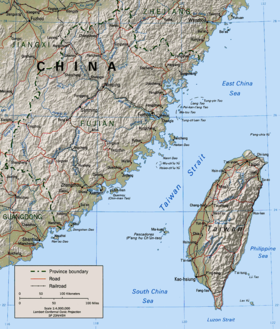Second Taiwan Strait Crisis
| Second Taiwan Strait Crisis | |||||||
|---|---|---|---|---|---|---|---|
| Part of Cold War and Chinese Civil War | |||||||
 Taiwan Strait |
|||||||
|
|||||||
| Belligerents | |||||||
|
|
|
||||||
| Commanders and leaders | |||||||
|
|
|
||||||
| Strength | |||||||
|
|
|
||||||
| Casualties and losses | |||||||
| 440 ROC troops killed | 460 PRC troops killed, 218 civilians killed. | ||||||
The Second Taiwan Strait Crisis, also called the 1958 Taiwan Strait Crisis, was a conflict that took place between the People's Republic of China (PRC) and the Republic of China (ROC) in which the PRC shelled the islands of Kinmen and the nearby Matsu Islands along the east coast of the PRC (in the Taiwan Strait) to "liberate" Taiwan from the Chinese Nationalist Party, also called Kuomintang (KMT), and probe the extent of the United States defense of Taiwan's territory.
The crisis started with the 823 Artillery Bombardment (Chinese: 八二三砲戰; pinyin: Bā'èrsān Pàozhàn; Pe̍h-ōe-jī: Pat-jī-sam Phàu-chiàn) at 5:30 pm on August 23, 1958, when the PRC's People's Liberation Army (PLA) began an intense artillery bombardment against Quemoy (Kinmen). The ROC troops on Kinmen dug in and then returned fire. In the heavy exchange of fire, roughly 440 ROC soldiers and 460 PRC soldiers were killed.
This conflict was a continuation of the First Taiwan Strait Crisis, which had begun immediately after the Korean War was over. The Nationalist Chinese had begun to build on the island of Kinmen and the nearby Matsu archipelago. During 1954, the PLA began firing artillery at both Kinmen and some of the nearby Matsu islands.
...
Wikipedia
